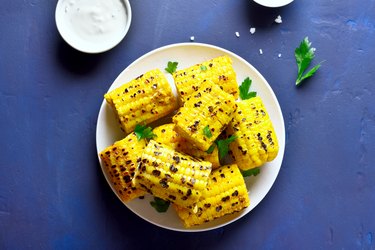
Have you ever noticed that corn on the cob tastes so good when cooked almost immediately after being picked? It's nearly impossible to keep fresh corn at its best for long, but if you master the easy art of frozen corn on the cob, you can enjoy this summertime treat throughout the year.
The Ideal Ear of Corn
Video of the Day
Known for its sweet, juicy taste and its bright yellow color, corn is a vegetable that's great for your taste buds and for your body. According to Iowa State University, corn is a good source of vitamin C, which helps heal cuts and wounds and gives a boost to the immune system. Corn is also rich in lutein, an antioxidant that helps ward off eye disease. And it has plenty of fiber for lowering your cholesterol and for fighting heart disease.
Video of the Day
But those natural sugars that give corn its sweet taste don't last long after the corn is picked from its stalk. In fact, Utah State University notes that without proper storage, corn can lose its sweetness in only a few days.
This is why you should ideally process corn on the cob a couple of hours after it is picked — even if that means just blanching it and freezing it so you can cook it and enjoy it at a later date. Fortunately, frozen corn on the cob will keep very well for about four to six months, as Iowa State University estimates.
Frozen Corn on the Cob
To freeze corn on the cob, start by shucking the corn and removing its silky hairs. After that, trim the ends off and wash it. Then you need to blanch the corn.
Blanching the corn is described as an important step by Utah State University. Put the ears in a gallon of water and bring to a boil. Once the water is boiling, start watching the time: Small ears should be boiled for seven minutes to blanch properly.
Medium ears should be boiled for nine minutes and large ears should be blanched for 11 minutes. Remove the corn from the boiling water and transfer it to cold water just long enough for the cob to cool. Careful though — don't keep it in cold water so long that the corn starts to go soggy.
Once you have drained the corn, wrap each ear in foil and freeze at a temperature of zero degrees Fahrenheit or colder.
Michigan State University recommends blotting after draining, wrapping the ears in film and putting them in a freezer bag. The university also notes that you should not freeze more than 1 quart of food per cubic foot of freezer space per day; if you exceed this amount, it will take too long for the products to reach a frozen state and the freezer will be forced to overwork.
The beauty of frozen corn on the cob is that after you have thawed it, you can use it for many corn on the cob recipes. Nearly everyone has what they would consider the best way to cook corn on the cob.
North Carolina Agriculture praises corn for being easy to prepare and equally delicious whether you put it in the oven, on the stovetop, on the grill or even in the microwave. However, the grill is not the best way to cook corn on the cob if you're working with frozen ears because this technique calls for the corn to be cooked still in its husk.
Read more: How to Roast Vegetables the Day Before
These tips will help ensure you can take a frozen ear and use it for any corn on the cob recipe without overcooking it or letting it go bad. Of course, there is one more easier option: You can buy packaged corn on the cob from the grocery store and follow the instructions on the packaging.
- Utah State University: “Corn”
- North Carolina Agriculture: “Recipe: Corn on (and off) the Cob”
- Iowa State University: “Corn on the Cob”
- Iowa State University: “Corn on the Cob: A Sure Sign of Summer”
- Michigan State University: “How to Freeze Corn Now and Enjoy It Later”
- Utah State University Extension; Corn; Heidi LeBlanc, et al.; March 2010